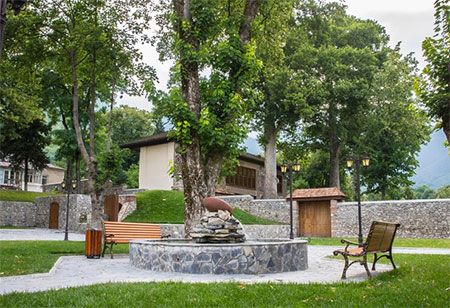
Creating a tranquil and refreshing outdoor space has become a priority for many in our fast-paced urban lives. A well-designed outdoor area not only enhances the aesthetics of your property but also provides a retreat for relaxation and connection with nature. In this article, we explore the art of landscape design and how you can transform your space into a green oasis that rejuvenates the mind, body, and soul.
Creating a green oasis starts with careful planning and envisioning your ideal outdoor space. Consider the layout of your property, the existing landscape features, and your lifestyle preferences. Determine how you want to use the space-whether for entertaining guests, gardening, or simply relaxing. This initial planning phase lays the foundation for the rest of your landscape design journey.
When planning, consider the focal points and areas in your landscape. Focal points can be created using large trees, sculptures, or water features, while focal areas can be designed with seating arrangements, fire pits, or garden beds. These elements draw the eye and create visual interest, enhancing the overall beauty of your green oasis.
Selecting the right plants is crucial for a thriving green oasis. Consider your climate zone, sun exposure, soil type, and water availability. Opt for a mix of trees, shrubs, flowers, and ground covers to create a balanced and visually appealing landscape. Native plants are often a wise choice as they are adapted to the local environment and require less maintenance. Explore drought-resistant species and seasonal varieties to ensure year-round beauty in your garden.
In addition to aesthetics, think about the functionality of plants in your landscape. For example, shade trees can provide relief from the sun and reduce energy costs, while flowering plants attract pollinators and add color to your garden. Incorporating edible plants like herbs, fruits, and vegetables can also turn your green oasis into a productive and sustainable space.
Hardscaping elements play a significant role in landscape design, providing structure, functionality, and visual interest to your outdoor space. To enhance the overall design, consider incorporating pathways, patios, decks, pergolas, and water features. Choose materials that complement your home's architecture and blend seamlessly with the natural surroundings. Pay attention to layout and flow, creating inviting spaces encouraging exploration and relaxation.
When designing hardscaping features, consider how they interact with the surrounding landscape. For example, a meandering pathway can lead visitors through different garden areas, while a patio or deck can serve as a gathering space for outdoor activities. Water features like ponds or fountains add beauty, attract wildlife, and create a soothing ambiance.
Outdoor living areas are essential for maximizing the enjoyment of your green oasis. Design comfortable seating areas, dining spaces, and lounging zones where you can unwind and entertain guests. Select durable and weather-resistant furniture, cushions, and accessories that withstand outdoor conditions. Incorporate lighting solutions to extend the usability of your outdoor space into the evening hours, creating a magical ambiance under the stars.
Consider the functionality of outdoor living areas based on your lifestyle. For example, a cozy fire pit area is perfect for cool evenings and gatherings with friends, while a dining patio allows for alfresco meals and family gatherings. Enhance these areas with soft furnishings, outdoor rugs, and decorative elements that reflect your style and create a welcoming atmosphere.
Explore a wide range of sustainable and stylish planters for your green oasis at Pots Planters & More.
Sustainability is a key consideration in modern landscape design. Implement eco-friendly practices to minimize water usage, reduce waste, and promote biodiversity. Consider installing rainwater harvesting systems, using permeable paving materials, and in- corporating native plantings to support local wildlife. Composting organic waste and mulching garden beds contribute to soil health and fertility. By embracing sustainable practices, you can create a green oasis that benefits the environment and your well-being.
In addition to sustainable practices, think about the long-term maintenance of your green oasis. Choose low-maintenance plants and hardscaping materials that require minimal care and upkeep. Design irrigation systems that efficiently water your landscape while conserving water. Incorporate mulch and ground covers to suppress weeds, retain moisture, and improve soil health. You can create a thriving and resilient green oasis by designing with sustainability and maintenance in mind.
Regular maintenance is essential to keep your green oasis thriving year after year. Develop a maintenance schedule that includes watering, fertilizing, pruning, and pest control tasks. Monitor plant health and address any issues promptly to prevent problems from escalating. Seasonal cleanups, mulching, and soil amendments help nourish your plants and maintain a vibrant landscape. Consider consulting with a professional landscaper for specialized care and guidance.
Incorporate seasonal tasks into your maintenance routine to keep your green oasis looking its best throughout the year. Spring may require pruning and fertilizing to promote new growth, while summer focuses on watering and pest management. Fall is ideal for planting and mulching to prepare for winter, and winter may involve protective measures for sensitive plants and winter interest features like evergreens and berries.
Creating a green oasis through landscape design is a rewarding journey that enhances your quality of life and connection with nature. You can transform your property into a haven of beauty and tranquility by carefully planning, choosing the right plants and hardscaping features, incorporating sustainable practices, and maintaining your outdoor space. Embrace the art of landscape design and experience the joy of a green oasis right outside your doorstep.
We use cookies to ensure you get the best experience on our website. Read more...